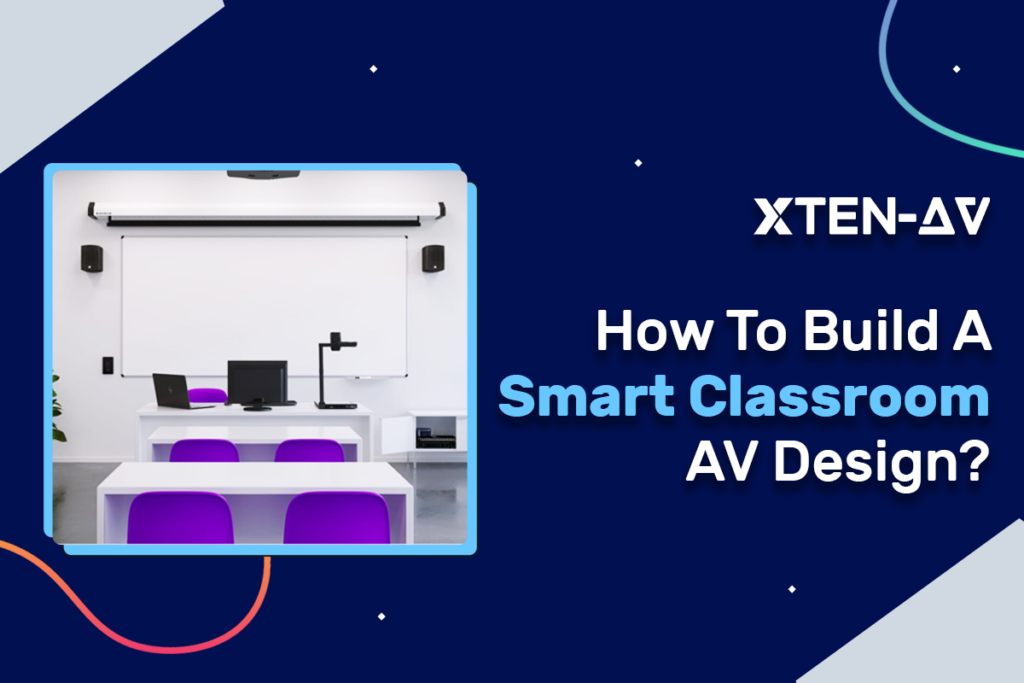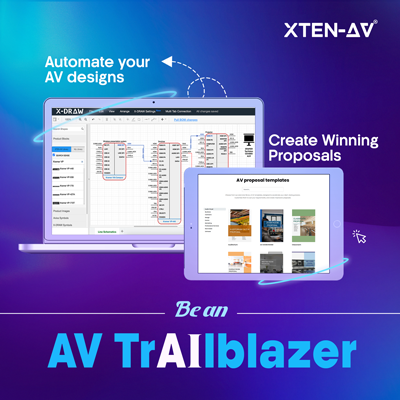Struggling With AV? How Control Systems Can Make Your Life 10X Easier!
A smart classroom consists of various elements to ensure that the learning is effective. Classroom AV design plays a vital role in creating this experience for students. Before we start designing, let’s take a minute to understand the concept of a smart classroom and what it includes. It’s not just a modern room with devices. It’s a space that is ready to beat the traditional ways of teaching, it’s a whole new learning experience for the students. This blog is dedicated to building a smart classroom audio visual design. Make sure to follow the steps to ensure your design is future-proof and scalable.
Assessing The Basic Environment For Classroom AV Design!
The first step towards a good classroom AV design is analyzing the environment. This will include everything that the classroom is equipped with, including the dimensions of the room and every other factor that can contribute to better engagement and enhanced learning. Here, we have explained how you can analyze the basic environment:
How to Evaluate the Classroom’s Infrastructure?
The easiest way to understand the infrastructure of any classroom is to first check the condition of the room. This will include many things, such as the electricals. If you need to make any changes, then look at the space availability to understand what better changes can be implemented. Last but not least, the power sources. Ensure you are aware of each and every power source available in the room so your classroom AV design is planned accordingly.
How to Analyze Classroom Dimensions?
Next, analyze the room’s dimensions. Once you have the classroom’s dimensions, it will be easier for you to include any kind of audiovisual technology as you have an in-depth analysis of the space. As you complete this process, we suggest that you simultaneously maintain a list of classroom AV equipment requirements to avoid any hassle in the installation stage.
Finally, Review the Classroom Floor plan and Facilities
Now that you have allotted enough time for investigation and collected enough information, it’s time to evaluate the classroom floor plan and its present technology. You are now equipped to create a classroom AV design based on the tactics developed using the above results.
Finalize the Classroom’s Audio Visual Design with the Information Gathered Above
As we’ve understood, the first step that includes in-depth research and analysis of the classroom. Let’s move forward to the next and most important step, which is Crafting a well-researched Classroom audio visual design. Here are some things to keep in mind while in the designing phase:
Use AV design tools instead of working manually
Utilize XTEN-AV’s cloud-based platform to simplify your classroom audio visual design process and replace tedious human labor with effective AV design tools. Give up the headache of juggling several general-purpose tools and switch to one designed especially for audiovisual design in classrooms.
Focus on automation to save time
Utilize classroom AV design templates and exclusive drawing automation technology to create your classroom AV diagrams more quickly. Now that you have automation at your disposal, focus on refining your design instead of letting monotonous manual labor consume your time.

Incorporate newer tech like VR/ AR to create more sustainable/future-proof designs
By integrating revolutionary technologies like VR and AR into the audiovisual design of your classroom audio visual system, you can stay ahead of the competition. With the help of XTEN-AV’s cutting-edge platform, you Can build more sustainably and futuristically, promising that your classroom is ready for the changing demands in the education sector.
Using all-equipped pro-AV tools/software to improve efficiency
Increase your productivity by 10X With the Classroom audio visual system design software from XTEN-AV. Ditch the limitations of desktop-based solutions and welcome a cloud-based platform that provides all the features you want to simplify the whole classroom audiovisual design process.
AV Design Mastery + Winning Proposals = 10x Productivity!
- Automatic Cable Labeling & Styling
- 100+ Free Proposal Templates
- Upload & Create Floor Plans
- 1.5M Products from 5200 Brands
- AI-powered ‘Search Sense'
- Legally Binding Digital Signatures
Implementing Smart Classroom Solutions for Enhanced Learning
The last step in this series is the implementation stage. The success of a smart classroom audio video design largely depends on its implementation phase. To guarantee the effective integration of AV technologies across the classroom, it’s necessary for audio visual integrators to ensure user training for future scalability and maintenance.
In order to fully utilize the technology, staff, students, and instructors need to take part in extensive user training sessions. The long-term sustainability of the smart classroom AV control system depends on scalability. A robust infrastructure for maintenance and support is necessary for the long-term operation of intelligent technologies. In order to minimize downtime and extend the lifespan of smart solution deployments, organizations should establish regular procedures for frequent technology maintenance, troubleshooting, and upgrades.
How can planning and consideration enhance your Classroom’s audio visual design?
Building a smart classroom design that enhances students’ engagement and learning is not easy. It requires expertise and planning. Without these two, the idea of a smart classroom’s audio visual design will definitely be a flop. Each element, from the room design to technology, visibility, lighting, etc., is a consideration that only an audio visual expert can take care of. Planning is the backbone for offering a successful smart classroom experience.
What Are the Benefits of Planning an Audio Video Design for a Classroom?
As an Audio video classroom design expert, it’s your responsibility to understand what importance AV technology holds for students and teachers. Here we have listed a few benefits that students can get through the right audio visual tech.
Improved Student Participation
Increased participation makes the classroom dynamic, encouraging students to participate fully, share ideas, and make connections with the material. Using interactive classroom audio video solutions helps students become more engaged in class activities and take ownership of their education by creating a feeling of engagement.
Improved Cognitive Learning
The cognitive processes stimulated by modern classroom AV technologies help with material retention and deeper comprehension. Teachers may enhance their students’ cognitive development, critical thinking skills, and overall academic accomplishment by utilizing interactive presentations and multimedia resources.
Promotes Technology Learning
By using the right classroom AV solutions, educators may foster students’ technical literacy and flexibility while promoting hands-on inquiry and familiarity with digital technologies. Students who are exposed to AV technology in the classroom develop critical skills for navigating the digital world, setting them up for success in a society that is becoming more and more tech driven.
Promotes Classroom Collaboration
Collaborative audiovisual systems promote peer-to-peer learning and information exchange by enabling students to communicate and work together more easily. Instructors foster a collaborative learning environment by encouraging group projects, conversations, and problem-solving activities among their students. This fosters a climate of classroom collaboration and teamwork.
Conclusion
A classroom AV design must be carefully planned, analyzed, and integrated with cutting-edge technologies. XTEN-AV’s automation and cloud-based platform can expedite the design process and produce educational environments that are ready for the future. VR and AR integration guarantees that classes may change to meet changing student demands. Implementation success requires user training, scalability concerns, and a strong maintenance infrastructure.
Thoughtful preparation improves participation and learning, laying the groundwork for education’s future. Successfully applying audiovisual design for education requires prioritizing creativity, teamwork, and quality.
Frequently Asked Questions
The design of audiovisual systems for educational settings is known as AV system design for schools. In order to promote efficient communication and improve the educational experience for both students and teachers, it involves the selection and integration of AV equipment like as projectors, interactive displays, and sound systems.
AV technology enhances education in schools by providing dynamic multimedia materials that accommodate a variety of learning styles. Immersive learning environments, visual aids, and interactive courses help students become more engaged and retain more of the material being taught. It also promotes teamwork and active engagement, fostering an engaging and dynamic learning environment.
Schools may guarantee the security of their AV systems by implementing several safeguards, including network segmentation, encryption protocols, and access limits. Regular software updates, firewall defense, and monitoring tools can also be used to identify and stop cyberattacks and unwanted access, protecting confidential information and maintaining the integrity of antivirus software.
School employees benefit from AV system training because it gives them the information and abilities they need to integrate AV technology into their lesson plans. Training sessions cover topics such as operating AV equipment, troubleshooting common issues, and integrating multimedia resources into lesson plans. This empowers staff to deliver engaging and interactive lessons, enhancing student learning outcomes and overall classroom experiences.


